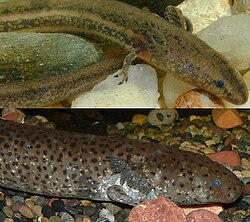bio.wikisort.org - Animalia
Los sirénidos (Sirenidae) son un clado compuesto de por lo menos 4 especies de anfibios caudados que se distribuyen en el sureste de los Estados Unidos y el noreste de México.[1] Exhiben cuerpos alargados adaptados a una vida completamente acuática, una ausencia de dientes pedicelados, extremidades reducidas (careciendo de las posteriores) y pedomorfismo al retener las branquias en la etapa adulta, el sistema de la línea lateral y una alimentación por succión (aunque poseen una mandíbula móvil).[2]
| Sirenidae | ||
|---|---|---|
 Siren intermedia y Pseudobranchus striatus | ||
| Taxonomía | ||
| Reino: | Animalia | |
| Filo: | Chordata | |
| Superclase: | Tetrapoda | |
| Clase: | Amphibia | |
| Subclase: | Lissamphibia | |
| Orden: | Caudata | |
| Familia: |
Sirenidae Gray, 1825 | |
| Géneros | ||
Véase el texto. | ||
Los primeros estudios moleculares posicionaban a Sirenidae como el grupo hermano del resto de las salamandras, pero análisis posteriores de secuencias de genes nucleares sugerían al clado Cryptobranchoidea (Cryptobranchidae e Hynobiidae) como el más basal.[3][4][5] Por otra parte, Zhang & Wake (2009) volvieron a posicionar a Sirenidae acorde a los primeros estudios, respaldando, además, al clado conformado por aquellas grupos con fertilización interna, por lo que la fertilización externa (presente en Sirenidae, Cryptobranchidae e Hynobiidae) sería un carácter plesiomórfico.[6]
Cladograma
| Sirenidae |
| ||||||||||||||||||
Cladograma basado en Moler & Kezer (1993) y Frost et al. (2006).[7][4]
Taxonomía
Sirenidae se subdivide en cinco géneros, tres extintos y dos vivientes:
- Género †Habrosaurus Gilmore 1928
- †H. dilatus Gilmore 1928
- †H. prodilatus Gardner 2003
- Género †Kababisha Evans et al. 1996
- †K. humarensis Evans et al. 1996
- †K. sudanensis Evans et al. 1996
- Género †Noterpeton Rage et al. 1993
- †Noterpeton bolivianum Rage et al. 1993
- Género Pseudobranchus Gray 1825
- †P. robustus Goin and Auffenberg 1955
- †P. vetustus
- P. axanthus Netting & Goin 1942
- P. striatus LeConte 1824
- Género Siren Österdam 1766
- †S. dunni Goin and Auffenberg 1957
- †S. hesterna
- †S. miotexana
- †S. simpsoni
- S. intermedia Barnes 1826
- S. lacertina Linnaeus, 1766
- S. reticulata Graham, Kline, Steen, Kelehear, 2018
Referencias
- Frost, D.R. «Sirenidae». Amphibian Species of the World: an Online Reference. Version 6.1. (en inglés). Nueva York, EEUU: Museo Americano de Historia Natural. Consultado el 19 de mayo de 2014.
- Duellman, W. E. & Trueb, L. (1994) Biology of Amphibians. Johns Hopkins University Press. ISBN 978-0-8018-4780-6.
- Wiens, J. J. et al. (2005) Ontogeny discombobulates phylogeny: Paedomorphosis and higher-level salamander relationships. Systematic Biology 54:91-110.
- Frost et al. (2006) The Amphibian Tree of Life. Bulletin of the American Museum of Natural History 297: 1–291.
- Roelants, K. et al. (2007) Global patterns of diversification in the history of modern amphibians. Proceedings of the National Academy of Sciences of the USA 104: 887-892.
- Zhang, P. & Wake, D. B. (2009) Higher-level salamander relationships and divergence dates inferred from complete mitochondrial genomes. Molecular Phylogenetics and Evolution 53, 492-508.
- Moler, P. E. & Kezer, J. (1993) Karyology and systematics of the salamander genus Pseudobranchus (Sirenidae). Copeia 1993:39-47.
Bibliografía
- Gardner, J. D. (2003) Revision of Habrosaurus Gilmore (Caudata; Sirenidae) and relationships among sirenid salamanders (enlace roto disponible en Internet Archive; véase el historial, la primera versión y la última).. Palaeontology 46(6):1089-1122(34).
- Larson, A. (1991) A molecular perspective on the evolutionary relationships of the salamander families. Evolutionary Biology 25:211-277.
- Liu, F. R. et al. (2004) Allozyme Variation in the Salamander Genus Pseudobranchus: Phylogeographic and Taxonomic Significance. Copeia 1:136-144.
- Liu, F. R. et al. (2006) Phylogeography of the salamander genus Pseudobranchus in the southeastern United States (enlace roto disponible en Internet Archive; véase el historial, la primera versión y la última).. Molecular Phylogenetics and Evolution 39:149-159.
Enlaces externos
На других языках
[de] Armmolche
Die Armmolche (Sirenidae) sind eine urtümliche Familie der Schwanzlurche innerhalb der Klasse der Amphibien, die als Dauerlarven (vergleiche: Neotenie) in Gewässern vom Südosten der USA bis in den Nordosten von Mexiko vorkommen.[1] Ihren Namen tragen sie, weil sie vordere Extremitäten, aber keine Hinterbeine aufweisen. Das Taxon ist bereits für die Zeit vor 130 Millionen Jahren fossil belegt.- [es] Sirenidae
[ru] Сиреновые
Си́реновые[1], или си́рены[1] (лат. Sirenidae) — единственное семейство подотряда Sirenoidea, входящее в отряд хвостатые земноводные (Caudata). Семейство, включающее пять видов, объединённые в два рода.Другой контент может иметь иную лицензию. Перед использованием материалов сайта WikiSort.org внимательно изучите правила лицензирования конкретных элементов наполнения сайта.
WikiSort.org - проект по пересортировке и дополнению контента Википедии